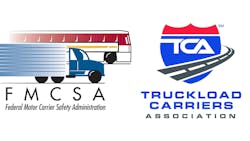Due to the COVID-19 pandemic, the 39th Annual Safety & Security meeting held by the Truckload Carriers Association was a virtual event, with attendees watching the first day of presentations on June 23 from their computers and smart devices. And instead of pacing the expo floor to check out trucking suppliers’ wares, attendees used a mouse or finger to browse the vendor showcase page. The topics highlighted in the Trucking Executive Panel and Federal Motor Carrier Safety Administration (FMCSA) Fireside Chat all had very serious real-world implications, though.
Chief among them were the FMCSA’s final rule for hours of service (HOS), which goes into effect Sept. 29, and the Drug & Alcohol Clearinghouse. During the Fireside Chat portion, Acting FMCSA Administrator Jim Mullen and David Heller, TCA vice president of Government Affairs, spoke at length about these with moderator Dave Nemo, a host on the Road Dog Trucking satellite radio channel.
Hours of Service
After touching on the COVID-19 issues still affecting the country, Mullen, Heller and Nemo tackled the four main revisions to HOS:
- Flexibility on the 30-minute break by allowing a driver to use “on-duty, not driving status” to fulfill the rule, rather than off-duty status.
- Sleeper-berth exception to allow drivers to split their required 10 hours off duty into two periods: an 8/2 split, or a 7/3 split—with neither period counting against the driver’s 14‑hour driving window.
- Adding two hours to the maximum window for the adverse driving conditions exception during which driving is permitted.
- Changing the short-haul exception from 12 to 14 hours and increasing the operating distance limit from 100 air miles to 150 air miles.
“The focus of the all the changes is greater flexibility for the driver,” Mullen said. “He or she who's operating the truck knows best when he or she should be operating.”
These revisions were issued in May, but the 120-day interim period for enactment was to allow electronic logging device (ELD) vendors to catch up and ensure the “major component of compliance” were correctly reprogrammed, Mullen said.
Drivers and fleets must also tweak their thinking to take advantage of the increased flexibility. During a 30-minute break, a trucker may want to move his or her tractor from a sunny to shady spot, Mullen theorized. That would be logged as “personal conveyance," but if the truck had to be moved for a loading operation, that would count as duty time.
Mullen said this deregulatory change received near-universal approval from the industry and was the key change.
Heller was surprised at how quickly the FMCSA processed the more than 5,000 comments on the changes.
“This might have been record speed for getting a rule out,” Heller said. “I remember the days where it was a good two years between [the advanced notice of proposed rule making] and notice of proposed rule and making it onto a final rule.”
“Flexibility was our big issue: that 14-hour clock and the ability to stop that,” Heller said. “Finding that 7/3 split and being able to break up the day is paramount.”
He said the TCA would have preferred a 6/4 and 5/5 split, but technology may make way for that possibility in the next few years.
“We've got tools and devices on our trucks nowadays that are tracking some of these things, and we’ll know much better a year or two down the road whether that window to a six and four split or five and five split can actually be opened again,” Heller said.
Nemo believed the 5/5 split going away led to drivers leaving.
“I really think that the 'empty-nester type' husband and wife teams would come back,” he said, asking Mullen if that may someday return.
“The door certainly is not shut to that,” Mullen said. “An option is to do a pilot program on allowing six and four or five and five to study it that way.”
Mullen acknowledged there’s a balance between meeting the six-hour “restorative sleep” goal and the fact that “truck drivers lead a very different life" than those who work nine to five.
Drug & Alcohol Clearinghouse
Mullen noted that 24,000 drivers have tested positive for drugs or alcohol since the Drug & Alcohol Clearinghouse went active. In the first few weeks of operation, that number was 8,000, so at first glance, it appears the rate of positive tests has slowed. Mullen said the results indicated positive change for the industry.
“It's good news that 24,000 individuals who have tested positive have been identified,” he said. “They're not able to circumvent this by not telling a future employer that they tested positive at their former employer. The intent of the clearinghouse is to prevent that sort of trucking company shopping, in hiding your past.”
He also said the Return to Duty program could help drug and alcohol abusers recover and get back on track. As of June 22, 257 drivers violated the return to duty rules, with 229 testing positive and 28 refusing to be tested. Only two were for alcohol.
Mullen did express regret over the website’s technical difficulties in the first few days. Those may be unavoidable, as the Fireside Chat itself was delayed by 20 minutes due to technical difficulties. Mullen did say the FMCSA is working to make accessing the clearinghouse platform easier.
The issue of hair testing versus urine testing was also raised.
“We're looking very closely at whether that's permitted and if not, how it ought to be permitted,” Mullen said, adding it’s “under deliberation and advisement right now.”
That was also the consensus from discussions during the earlier executive panel.
“Hair testing has a nine times greater positive rate than urine testing,” said Dave Williams, executive vice president at Knight Transportation. “If for every 100 tests, you have three positives in urine, you would have 27. You'd basically have 24 people for every hundred that you're hiring that are active drug users. They were just clean enough to pass that particular urine test. As an industry, I hope that gives everybody pause.”
About the Author
John Hitch
Editor
John Hitch is the editor-in-chief of Fleet Maintenance, providing maintenance management and technicians with the the latest information on the tools and strategies to keep their fleets' commercial vehicles moving. He is based out of Cleveland, Ohio, and was previously senior editor for FleetOwner. He previously wrote about manufacturing and advanced technology for IndustryWeek and New Equipment Digest.

